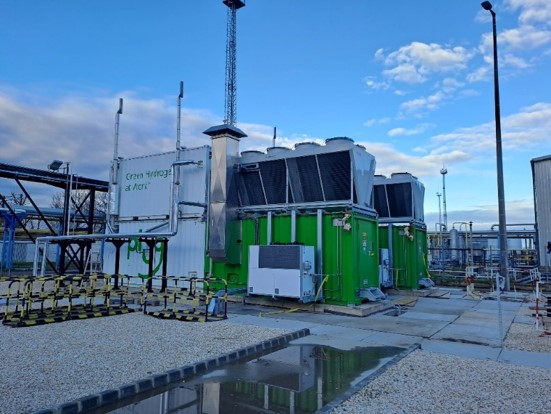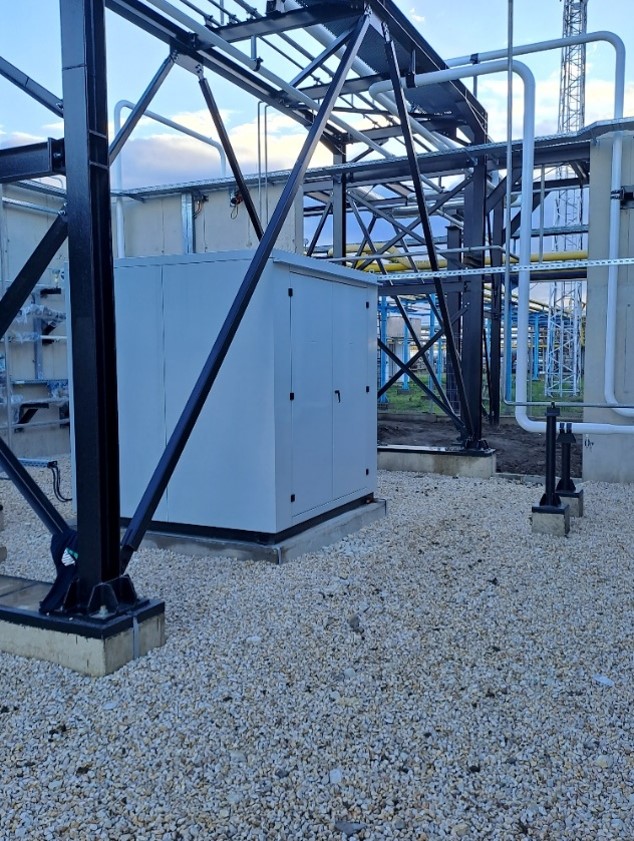Status March 2023
Another
important milestone has been reached: on March 24, 2023, the on-site civil,
mechanical, electrical and instrumentation/process control construction works
of the Aquamarine project were completed at the Kardoskut UGS. The preparation
of the trial operation of the new process system built within the framework of
the project has then started: according to plans, the trial operation of the
main and auxiliary system began and will continue in the coming weeks following
the operational tests.



Status December 2022
The construction works of the Aquamarine Project have reached another important milestone: between 20 and 21 December 2022, the electrolyser units (two 1.0 MW units) producing hydrogen and buffer tanks for the temporary storage of approximately 18 000 m3 of hydrogen were installed in their final location.
With the completion of these works, the last key "container elements" have been put in their final place. Therefore, following the preparation of installation, construction will now concentrate on completing the mechanical connections for these new technological elements and on establishing electrical and instrument connections. These construction tasks are expected to be completed by the end of Q1 2023, after which we will start the test operation of the new equipment group.

Status October 2022
On 29 September, the key equipment of the Aquamarine Project, the hydrogen compressor, was put into place. The 20 ton machine, with dimensions of 6.5 m x 2.5 m x 3.4 m, was positioned on the prepared concrete foundation by a crane with a 400 ton load capacity and a crew of 6. The complexity of the task resulted from the fact that due to the ongoing construction work on the site, it was not possible to access the compressor base, making it necessary to use a crane of this size and capacity. Successful installation also required to stabilize the crane on paved ground, so the distance between the crane's pivot point and the target location was 42 m, which could be reached with a boom length of 52 m. The whole process, from preparing the crane for lifting, through the execution of the task, to leaving the site, lasted a total of 10 hours. We expect that the project will not involve any further lifting of a similar magnitude, as foundations will be easier to access when installing the other pieces of equipment, and thus will not require a similar size of lever arm.

Once the lifting work was completed, the compressor supplier's staff carried out the levelling of the machine unit on the foundation. Following this, the anchor bolts and the machine base were cast using purpose-specific resin, which is suitable for evenly distributing high loads and is extremely resistant to corrosion, mechanical stresses, contamination and wear.

The purpose of the H2 compressor in place:
Hydrogen generated by electrolysers through water splitting is produced in the low-pressure buffer tank. When this tank is filled with hydrogen – which in practice means that the pressure within the tank is equal to the maximum operating pressure of the electrolyzers (38 barg) – the hydrogen produced is transferred from the low-pressure buffer tank to the high-pressure buffer tanks at an operating pressure of up to 200 barg using the two-stage diaphragm compressor (hydrogen compressor).
One of the functions of the compressor is therefore to transfer hydrogen to the high-pressure buffer tanks, or to feed the produced hydrogen directly after compression to the FGSZ blending circle, where it is blended into the natural gas stream entering the transmission pipeline network.
Status September 2022
With the project entering the implementation phase, finalized research results have been incorporated into our planning and construction processes, the site has been prepared and equipment foundations are being filled up. The electrolyser/compressor unit and the buffer system are expected to arrive in autumn, ready to be placed in their final location with the construction and mechanical work to be completed by then.
Regarding research and development, we have reached the final round of our materials technology tests and the LOHC storage technology’s semi-factory tests. Implementation has been assisted by further R&D programmes carried out in the meantime to explore the possibilities of using reservoir and industrial water, as well as the ways of using the oxygen produced during electrolysis.
The total budget of the project was revised to approximately HUF 5.266 billion, of which HUF 2.451 billion was funded by the Ministry for Technology and Innovation under the supervision of the National Research and Innovation Office.
Hungarian Gas Storage’s Project Aquamarine has started 1 February 2021
As part of the Aquamarine project Hungarian Gas Storage Ltd is intending to implement an electrolysis system with approximately 2,5 MW total performance and the corresponding hydrogen gas preparatory technology at the Kardoskut Underground Gas Storage site. Creating the system in this form carries a substantial innovative content to energy storage contept and contributes to the balance of the electricity system. By operating the electrolysis equipment, it can be ensured that instead of turning off (stopping production) renewable energy sources by using the surplus electric energy hydrogen could be produced by the decomposition of water. The hydrogen produced in this way mixed with natural gas will be utilized within the Gas Storage Ltd.’s own gas-operated equipment and reducing its own CO2 emission in this way. Furthermore, this natural gas mixed with hydrogen could be injected into the gas transmission system -strictly complying with gas quality and safety instructions – and will be part of the supply to end users. The spillover effect of the project will give ground to the widespread use of hydrogen utilization/-based technology. Through the implementation of the Aquamarine Project the Hungarian Gas Storage Ltd is strongly committed to the smart sector integration and also to playing an active role in the decarbonization processes.
The entire investment of the Aquamarine Project approximately comes to EUR 8 million, two thirds of which is tender support. The rest is provided by HGS. Due to tender support, there is a strict deadline for the project, which means that in all we have 24 months for completion including the procurement process and going live as well.

In the frame of Danube Region Strategy in 2019 Hungarian Gas Storage Ltd. prepared “Sustainable Energy Storage Innovations in Danube Region Countries for the EU-Goals of the Paris Climate Agreement” study.
